The Metropolitan Museum of Art – New York

Dry lacquer
with traces of gilt and polychrome pigments
38 x 27 in. (96.5 x 68.6 cm)
Rogers Fund, 1919 (19.186)
Buddhist images executed in dry lacquer were highly valued by the Chinese because of their costly and time-consuming process of production. There are so few surviving examples that this seated Buddha is especially precious. To fashion the body of the image, the craftsman made a rough form of the sculpture in clay and then applied at least three layers of hemp cloth, each secured with a paste made of raw lacquer (the sap from the lac tree, Rhus verniciflua) and a fine powder of bone, horn, shell, ceramic, stone, or carbon.
Each layer had to dry thoroughly before the next could be added. The clay core was then removed from the lacquered image. The head and hands were likely modeled separately, using the same technique as that used for the body, and then attached to the sculpture. The surface was finished with several coatings of pure lacquer and then painted.




